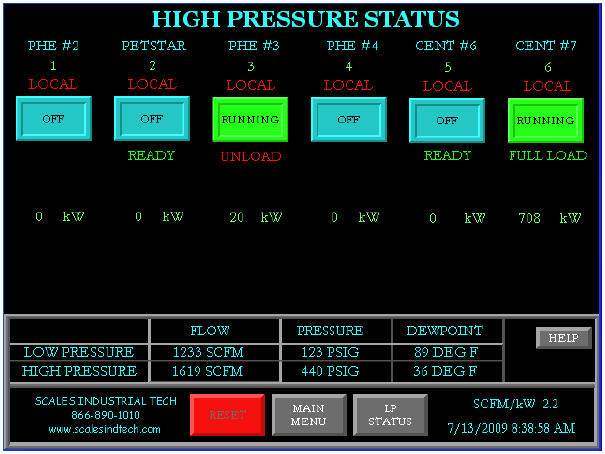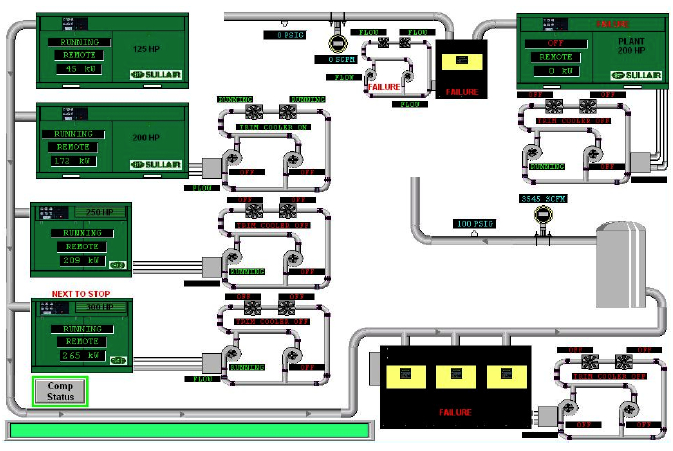Compressed Air Best Practices® Magazine interviewed Mr. Niff Ambrosino (Chief Operating Officer), Mr. Ernie Wichert (Systems Engineer) and Mr. Jeff Walker (Systems Engineer) from the Energy Services Division of Scales Industrial Technologies.
Good morning, please describe the \$mart Sequencer®?
Good morning. The \$mart Sequencer® is an air compressor control system designed to reduce a plant’s energy costs by continuously monitoring system demand and automatically selecting the most energy efficient combination of available air compressors.
The \$mart Sequencer® was launched by our firm in 2001 after years of conducting system assessments and using vendor-supplied compressor control systems. Our founder, Bill Scales, is the representative for all compressed air consultants to the U.S. Department of Energy’s Compressed Air Challenge®. In addition, five of our sales engineers are instructors for the Compressed Air Challenge® - the most of any organization in the nation. We drew upon this expertise when designing the \$mart Sequencer®.
Why is measuring flow important to measure demand?
Over the many years we have conducted system assessments, all over the world, one thing has always held true – compressed air systems always change. This is why we designed the \$mart Sequencer® to use multiple flow measurements, along with pressure readings, to establish the demand profile.
In order to measure demand, flow meters must be placed in the header(s) feeding the plant with compressed air. We recommend thermal mass-type flow meters; one for each header leaving each compressor room.
The \$mart Sequencer® is designed to take the actual flow and pressure measurements, from multiple compressor rooms up to 1 ½ miles apart, to establish a true demand profile in a real world operating environment.
What is wrong with using pressure to calculate flow?
There is nothing wrong with it - in a perfect world where nothing changes. Using pressure to back into your demand number (air flow) is a common practice after a system assessment has been done. Flow measurements are often taken during the system assessment and the solution will involve flow control valves, storage tanks and many other appropriate recommendations – which will be effective. Flow is calculated based upon the rate of change of pressure in a fixed volume (like a storage tank) and a demand profile is reached. Base-load air compressors are identified and trim-load compressors are sized up. A control system is installed to make the system function optimally – all based upon the demand profile calculations done at the point-in-time of the system assessment.

The \$mart Sequencer®’s Main Menu button on the Status Screen provides real-time SCFM/kW metrics to analyze the efficiency of the compressed air system.
What we have found with our many long-standing accounts is that over a period of time, the system will have changed and the compressor control system is no longer effective. In many cases, they become sized incorrectly and ineffective over time, as the demand changes.
The \$mart Sequencer®’s® ability to use actual flow to guide it’s decisions and air compressor selections makes it a compressor control system that adapts to changes in a compressed air system over time.
Does the \$mart Sequencer® work with any type of air compressor?
Absolutely. What is really unique about the \$mart Sequencer® is not so much how we measure demand, but what the system controller can do with this information and it’s ability to leverage the strengths of the onboard control systems of every type and brand of air compressor.
First and foremost, the \$mart Sequencer® does not make every machine an online/offline machine. This is a common short-coming of control systems supplied by air compressor manufacturers. The \$mart Sequencer® makes efficient use of every installed machine’s capabilities.
Some air compressors, for example, use displacement control and are most efficient between 40-100% of full-load capacity. The \$mart Sequencer® will employ the variable displacement capacity control as part of an overall control scheme. Other control system typically operate them as online/offline machines – at lower efficiencies.
So the \$mart Sequencer® tries to leverage the strength of each air compressor?
Correct. The \$mart Sequencer® makes full use of modulation, variable displacement, on-line/off-line and/or variable speed drives capacity controls. It has the capability to modulate multiple compressors, regardless of the manufacturer, simultaneously, when this results in the lowest power usage. This also allows the compressors to operate at the minimum pressure required by the plant. Storage based systems require that the trim compressors operate at elevated pressures, which increases the power required.
“Cascading” controls, for example, will set out “pressure bands” which determine which air compressor will turn on/off in a sequential order. This can work well in a new installation with four new air compressors from the same manufacturer. The \$mart Sequencer® automatically selects the correctly sized compressors for a given demand. It does not operate the compressors in a fixed sequence. For example, if the system demand increases by 500 cfm, the \$mart Sequencer® will automatically start the smallest compressor available that will provide the additional 500 cfm. Using the same example the \$mart Sequencer® may add a 1500 cfm compressor (if a 500 cfm compressor is not available) while turning off a 1000 cfm unit.
What we found, after years of system assessments, was that we were often dealing with six different air compressor sizes - from three different manufacturers - using four different compression and control technologies! A simple “sequencer” was inadequate.
The \$mart Sequencer® was therefore designed to be pre-programmed, before each job, to understand the strengths and efficiencies of the individual installed air compressors. This allows it to choose which air compressors should be running and which should be off – always based strictly upon selecting the most energy efficient way to satisfy the plant’s compressed air demand requirements.
Installations with centrifugal air compressors, for example, are great for the \$mart Sequencer®. Centrifugal air compressors use inlet guide vanes (or butterfly valves) to maximize their efficiencies at partial loads. The \$mart Sequencer® leverages this and continues to run the same air compressor down along the “sweet spot” of the curve of the guide vanes. The \$mart Sequencer is capable of “turning down” multiple centrifugal compressors simultaneously.
Although storage may be appropriate in some compressed air systems, it is just not a substitute for proper compressor control. In cases where there are large spikes in demand, or a reserve supply of compressed air is required, additional storage may be part of the solution. In thoese cases, the \$mart Sequencer® has the ability to control benefit from storage without the need of operating the compressors continuously at a higher storage pressure.
What type of software is used?
It uses commercially available software from Allen Bradley. The end user receives a copy of the program as well. We have noticed, as mechanics, that customers like this because it provides them with a clean copy for reference and as a back-up. If something isn’t working right, the program is there.
The \$mart Sequencer® connects to any manufacturer’s compressor control panel, which the operators are already familiar with. Each panel will have the ability to switch between remote and local, which allows any compressor to be removed from the system for maintenance, etc. The \$mart Sequencer® will automatically compensate, provided of course that there is adequate excess compressor capacity available.

The \$mart Sequencer® displays graphics representing the entire compressed air system as a whole. It includes each compressor and its operational status as well as system flow, pressure, and power.
Are there any remote monitoring capabilities?
Remote monitoring is possible with the system as is trouble-shooting and remote control. The customer can monitor in real time the current, average and peak flows in scfm - and it’s a real number. We also monitor the actual and average kW to produce that flow. We provide a straight-forward SCFM/kW metric. No calculations – just real data. A trend screen for all data is included
This SCFM/kW data now provides the customer with real-time metrics they can manage. How much air is produced and how much power was required to produce it? This is when improvements begin.
Thank you for your insights.
For more information please contact Jeff Walker, Scales Energy Services Division, Scales Industrial Technologies, tel: 610-955-9688, email: jwalker@scalesair.com, www.ScalesIndTech.com




